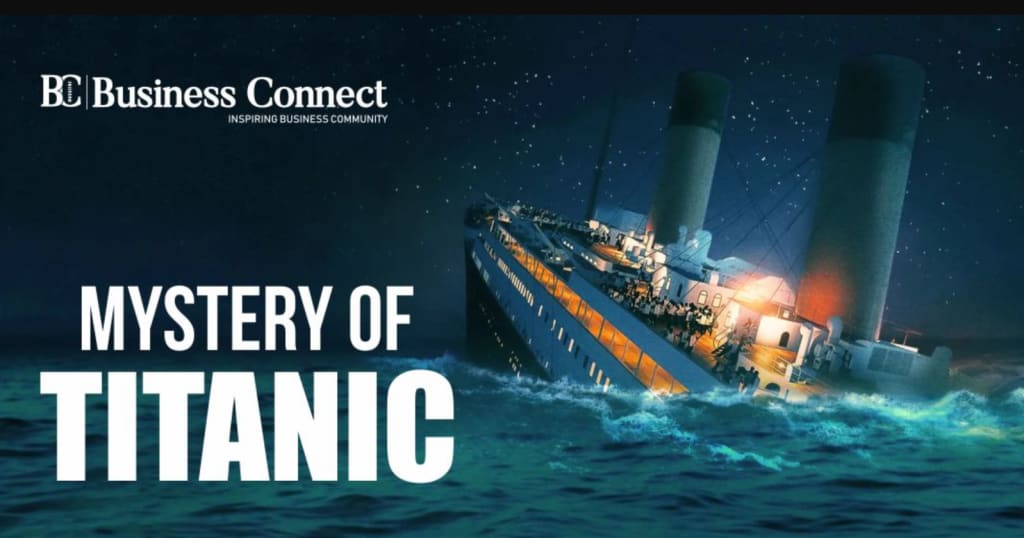Mystery of Titanic
How the World's Greatest Ship Disappeared?

On April 10th, 1912, the RMS Titanic embarked on its inaugural voyage, destined for New York from Southampton, England. This magnificent vessel, heralded as the largest and most luxurious ship of its time, boasted opulent amenities and accommodations that captured the imagination of the world. From renowned industrialists to hopeful immigrants seeking a new life in America, the Titanic welcomed passengers from all walks of life, promising an unforgettable journey across the Atlantic.
Under the command of Senior Captain Edward John Smith, the Titanic set sail amidst great excitement and fanfare. Its sheer size and grandeur, spanning 269 meters in length and towering over 53 meters high, were unparalleled. The cost of constructing such a marvel was staggering, amounting to 7.5 million dollars at the time, equivalent to a whopping 400 million dollars today. The interior of the ship resembled a palace, adorned with stained glass mirrors, ornate wood paneling, and lavish amenities including a heated swimming pool, Turkish bath, gymnasium, and multiple restaurants.
Despite its luxurious accommodations, the Titanic was also lauded for its advanced safety features, leading many to believe it was unsinkable. The ship's double-bottomed hull and compartmentalization into 16 watertight compartments were touted as innovations that would ensure its invincibility against any disaster. Confidence in the Titanic's safety was so high that the Vice President of the White Star Line, the company behind the ship's construction, famously declared it to be unsinkable.
However, tragedy struck on the fateful night of April 14th, 1912, when the Titanic encountered a field of icebergs in the frigid waters of the North Atlantic. Despite receiving numerous warnings of ice ahead, including seven warnings on the day of the collision, the Titanic maintained its course at a speed of 21.5 knots, equivalent to approximately 40 km/hr.
At 11:39 PM, lookout Frederick Fleet spotted a massive iceberg directly in the ship's path and sounded the alarm. Despite efforts to steer the ship away and slow its speed, it was too late. The Titanic collided with the iceberg, causing catastrophic damage to its hull. Within minutes, the unsinkable ship began to take on water, its fate sealed by a series of critical errors and oversights.
As the situation rapidly deteriorated, Captain Smith ordered distress signals to be sent out, desperately summoning nearby ships for assistance. The RMS Carpathia, the closest vessel, received the distress call and rushed to the Titanic's aid. Tragically, it arrived too late to prevent the ship from sinking beneath the icy waves.
In the chaos that ensued, the Titanic's inadequate supply of lifeboats became painfully apparent. With only enough lifeboats for half of the passengers and crew on board, panic and confusion reigned as people fought for survival. Despite the heroism of some crew members and passengers, including the band who famously played on as the ship sank, the loss of life was staggering.
In the aftermath of the disaster, investigations revealed a series of systemic failures and shortcomings that contributed to the Titanic's demise. From the complacency of the ship's operators to the lack of proper safety drills and the failure to heed ice warnings, a cascade of errors led to one of the deadliest maritime disasters in history.
The sinking of the Titanic served as a wake-up call to the maritime industry, prompting the implementation of stricter safety regulations and protocols. Measures such as the establishment of the International Ice Patrol and the International Convention for the Safety of Life at Sea (SOLAS) aimed to prevent similar tragedies from occurring in the future.
Despite the passage of time, the story of the Titanic continues to captivate the public imagination, serving as a poignant reminder of the fragility of human ambition in the face of nature's forces. The discovery of the ship's wreckage in 1985 and ongoing efforts to preserve its memory ensure that the legacy of the Titanic lives on, a testament to the enduring fascination with one of history's most iconic and tragic maritime disasters.
About the Creator
ava
The future belongs to those who prepare for it today
Enjoyed the story? Support the Creator.
Subscribe for free to receive all their stories in your feed. You could also pledge your support or give them a one-off tip, letting them know you appreciate their work.






Comments
There are no comments for this story
Be the first to respond and start the conversation.